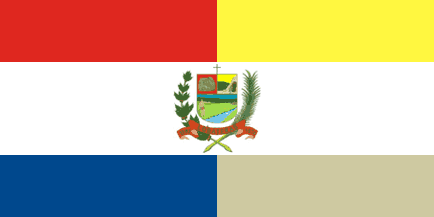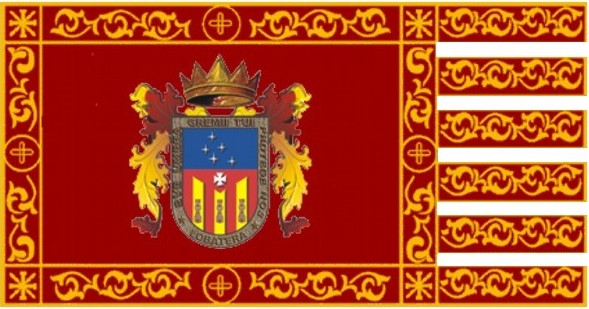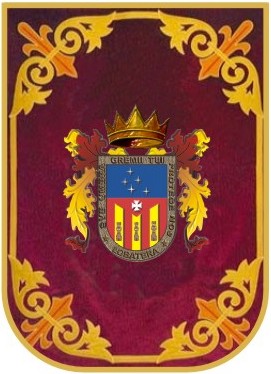 klaus-michael schneider
klaus-michael schneider
Keywords: tachira | lobatera |
Links: FOTW homepage | search | disclaimer and copyright | write us | mirrors

Last modified: 2021-08-26 by  klaus-michael schneider
klaus-michael schneider
Keywords: tachira | lobatera |
Links: FOTW homepage |
search |
disclaimer and copyright |
write us |
mirrors

by Jens Pattke (based on original by Doris
Danil Romero Varela ), 20 October 2004
See also:
Lobatera is a municipality in Tachira
State, as well a city which is the capital of the
municipality. The official resolution (in Spanish in pdf format)
can be seen here.
Samir A. Sánchez E., 25 May and 16 September 2004
The flag of Lobatera Municipality was designed by Profesora
Elda Consuelo Pacheco de Álvarez (1974).
Samir A. Sánchez E., 25 May 2004
The Municipal Council approved, on the 5 of May of 2004, to
modify the Flag of the City of Lobatera inasmuch as its present
design was complicated. Designed by Carlos Alviárez Sarmiento
and Samir A. Sánchez E. (2004).
Samir A. Sánchez E., 25 May 2004

from <www.monografias.com>
The Flag - Attributes and Semiology: Consists of a cloth with
approximated ratio 1:2; this is square and half of length with
dark red background. The hoist and central vertical thirds forms
the main body of the field in whose center appears the Coat
of Arms of the Municipality framed within an ornamented bordure
with diverse arabesque (lambrequins, circumferences, asterisks,
crosses) in gilded yellow, whereas the fly third is sectioned in
six dark red tails enriched with gilded yellow arabesque with
form of lambrequins. This singular design inspired in the
Venecianas flags alludes to to the meaning of the name given to
the territory of present Venezuela: "Pequeña Venecia"
(Little Venice) on August 24th, 1498. The dark red
represents the ground, the earth and the mounts that surrounds
Lobatera. Lambrequins symbolizes the nobility and austerity of
its inhabitants. The ornamental crosses recalls the cross that
from the same name hill ( "la cruz" in Spanish) towards
the north of the population has been vigilant witness of the
history of the locality. The six tails to the fly constitute a
tribute to the six ephemeris which have marked the citizen
history of the Municipality:
- Foundation of Lobatera by Don Pedro de Torres Vera on 1593
- Joint Holder's Movement on 1781
- Creation of the Civil and Ecclesiastical Parish of Lobatera on
1773
- Creation of Lobatera's Fairs and Celebrations on 1774
- Creation of the First Capitular Party of Lobatera on 1811
- Creation of the Canton of Lobatera in 1835
Historical Synthesis: Created by Professor Consuelo Pacheco, it
was adopted by then Lobatera District (today Municipality) in
1974.
Source: Article made by Professor Samir Sanchez at
<www.monografias.com>.
Raul Orta, 1 April 2004

from <www.monografias.com>
The Standard - Attributes and Semiology: Consists of a field
with approximated ratio 2:3; this is, square and half of length
with backgrpund in dark red, vertically oriented and with
the fly slightly rounded in the corners charging on the center
the Coat of Arms of the Municipality in all its official
attributes framed within a border ornamented with diverse
arabesque (lambrequins, pennants, flowers of lily) in gold
and crimson red. Judging by its design, it seems probable that
this standard is a protocolic representation of the Flag or
perhaps is the inverse thing and its semiology would make
emphasis in the dark red as representation of the ground, the
earth and the mounts that surrounds Lobatera whilst the
lambrequins would symbolize the nobility of its inhabitants and
the austerity of their customs.
Historical Synthesis: In occasion of the commemoration of the
Fourth Centennial of the Foundation of Lobatera (1593-1993), its
Mayor Office and Municipal Council approved the Coat of Arms and
the Standard designed by Licenciate Samir A. Sanchez E. in
Ordinary Session Nr. 13 dated on October 11th. 1991.
Source: Article made by Professor Samir Sanchez at
<www.monografias.com>.
Raul Orta, 1 April 2004
Designed by Profesora Elda Consuelo Pacheco de Álvarez
(1974).
Samir A. Sánchez E., 25 May 2004
Coat of Arms - Attributes: Consist in a Hispanic shape divided
per fess. The Chief or Superior Quarter enameled in Azure (blue)
charges five four-pointed stars put in bend three and two, the
second in ascending order with greater proportion with respect to
the rest. The Base or Inferior Quarter enameled in Gules (red)
loads three pales in Or (yellow) trimmed in chevron (triangular),
each one loaded with a battle-merloned tower in Argent (silver),
outlined in brown. Border in natural stone that loads as mottoes
the inscriptions "SVB UMBRA GREMIVM TVVM PROTECTS
US" (Protect us under the shade of your lap) to the Chief
and Flanks and "LOBATERA" in the Base, made in relief
capital gothic letters and separated each other by two
five-pointed stars. As external ornaments the blazon presents a
so called "Coronel": an ancient crown with five ends as
crest and lambrequins in Or (yellow) and Gules (red) to the Chief
and Flanks.
Semiology: On the First Quarter the five stars in Argent on field
of Azure represents Lobatera and the populations which integrate
their historical community, fruit of the pioneering and founding
action of the Lobaterensians: Lobatera, 1593; Borotá, 1831; San
Juan de Colón, 1831; Michelena, 1849 and San Pedro del Río,
1875. The stars disposition corresponds to its geographic
location on the relief of Tachirensian northwest; in
ascending order they are: Borotá, Lobatera, Michelena, San Pedro
del Río and San Juan de Colón. On the Second Quarter the blazon
of the Royal and Military Order of Our Lady of the Graces is a
filial tribute to the Holiest Virgin Mary in her invocations of
Our Lady of the Rosary of Chiquinquirá, Titular and Matron
of the population since 1773, and Our Lady of the Graces in whose
honor the Lobatera's traditional and bicentennial fairs and
celebrations are celebrated. The Castilian towers constitute the
heraldical representation of the last name "Torres" and
constitute an homage to Don Pedro de Torres Vera, founder of
Lobatera on the year 1593. The Border alludes to the historical
past of the locality standing out the fact of have been Canton
and Village that in 1856, with Canton and Village of San
Cristóbal, Canton and Village of San Antonio del Táchira and
the Canton and City of Holy Spirit Santo of La Grita, founded the
Province of Táchira, converted in State since 1864. The motto in
Latin language drift from a passage of the Holy Scriptures
(Deuteronomy 32, v. 11) with that it is desired to express the
Peace and Benignancy which offers the Lobaterensian home and land
to its children and to all those that shelter under its clear sky
and calm weather, specially to who moved away and passing the
time returns to the shelter and protection that it gives to the
spirit of the native ground i which saw born or grow them.
The word "LOBATERA" makes patent the local identity.
The "coronel" is a tribute to the warrior tribe
of the Lobateras Indian, pertaining to the great Caribbean
nation, that bequeathed to the posterity the name of the
locality. The lambrequins constitutes the representation of the
ocher ground and mounts which surrounds Lobatera, the
Nobility of its inhabitants and the Austerity of their customs.
Historical Synthesis: In occasion of the commemoration of the
Fourth Centennial of the Foundation of Lobatera (1593-1993), its
Mayor Office and Municipal Council approved the Coat of Arms and
the Standard conceived by Licenciate Samir A. Sanchez E. and
drawn by University Superior Technician Doris Danil Romero V. in
Ordinary Session N°. 13 dated on October 11th. 1991.
Source: Article made by Professor Samir Sanchez at
<www.monografias.com>.
Raul Orta, 1 April 2004
"Escudo de Armas de la Parroquia Constitución del
Municipio Lobatera". Designed by Profesor Horacio
Moreno (1993).
Samir A. Sánchez E., 25 May 2004